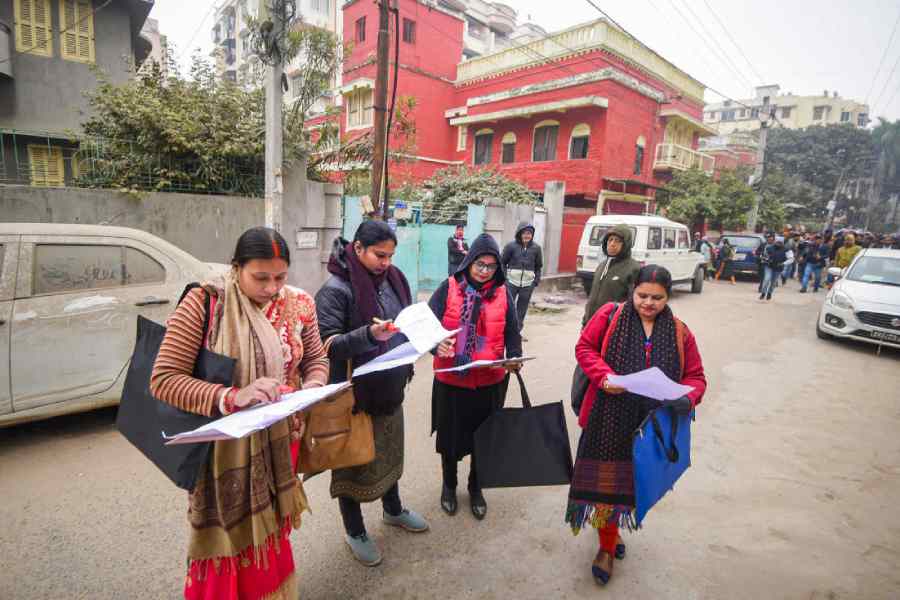The Centre is likely to conduct a population census from early 2025 after a four-year delay but has not yet decided on an accompanying caste census, government sources have said.
The population census, usually carried out every 10 years, was last conducted in 2011. A new one became due in 2021 but was postponed indefinitely because of
the pandemic.
“The census is expected to start early in 2025, with the population data to be declared by 2026,” a source in the Union home ministry said.
“No final decision has been taken yet on a caste census. Suggestions are being sought on whether a caste enumeration would be part of the general exercise.”
Last week, the Centre extended the tenure of Mritunjay Kumar Narayan, the Registrar General and Census Commissioner of India, till August 2026. His term was to end in December this year.
Till now, the population census has counted the Scheduled Castes and Scheduled Tribes separately but not the Other Backward Classes. It has also taken note of each Indian’s religion.
“There are suggestions, for instance, about adding the OBC category to the existing counts of SCs, STs and religions, and also about surveying sub-categories within the general, SC and ST categories,” the source said.
He said the four-year delay had led to a modification of the census cycle: the 2025 census will be followed by one in 2035.
The government has so far not made any formal announcement about the census.
Sources said a delimitation of Lok Sabha seats would start once the census is over, and would likely be completed by 2028, ahead of the next general election that will be due in 2029.
Led by the Congress, many Opposition parties have demanded a nationwide caste census, primarily so that the volume of reservations can be revised on the basis of its findings. Some BJP allies, such as the Janata Dal United and the Lok Janshakti Party, have backed the demand.
The BJP and the RSS are ideologically opposed to a caste census as it runs counter to their agenda of uniting the various castes under a single Hindutva umbrella.
Under pressure, the RSS has reluctantly agreed to a caste count while warning that the findings should be used only for “welfare activities” and not political purposes. It has cautioned that a caste census can endanger the “unity and integrity of Hindu society”.
Congress leader Jairam Ramesh on Monday urged the Centre to convene an all-party meeting to clarify matters relating to the caste census demand and the proposed delimitation of Lok Sabha seats.
“There is still absolutely no clarity on two crucial issues: Will this new census include a detailed enumeration of all castes in the country, in addition to that of Scheduled Castes and Scheduled Tribes that has been done in every census since 1951…” Ramesh said.
“Will this census be used for determining the strength of each state in the Lok Sabha”, something that might disadvantage “states that have been pioneers in family planning”, he asked.
During a media briefing last month, Union home minister Amit Shah did not rule out the possibility of the government accepting the demand for a caste census. He said the decision would be made public when the Centre announces the next population census.
The census can only begin a few months after the Registrar General of India receives certain data from the states.
Before every population census, the states are required to inform the RGI about the changes made since the last census to the number of notified districts, villages, towns and other administrative units such as tehsils, talukas and police stations.
The boundaries of the administrative units are frozen three months before the start of the census. During this period, the data is compiled and shared with the RGI, which begins its preparatory work for the census.
This time, Indians will have the option of “self-enumerating” themselves by filling in the census form online instead of waiting for government enumerators to visit their homes. For this, the census authority has designed a self-enumeration portal, but it is yet to be launched.
During self-enumeration, Aadhaar and mobile numbers will be mandatorily collected. Those who want to self-enumerate must first register themselves with the National Population Register.
The Office of the Registrar General and Census Commissioner has prepared 31 questions to be asked during the census. These include whether a family has a landline telephone, Internet connection, a (basic) mobile or smartphone, a bicycle, scooter, motorcycle, car, jeep or van.
Households will also be asked what cereals they eat; the main sources of their drinking water and lighting; their access to toilets; the types of the toilets; waste-water outlets; the availability of bathing facilities, a kitchen and LPG/ PNG connections; the main fuel used for cooking; and the availability of radio sets, transistors, and television sets.
They will also be asked about the predominant materials used in the floor, walls and roof of their house; the condition of the house; the number of people in the household; whether the head of the household is a woman, SC or ST; the number of dwelling rooms exclusively in the possession of the household; and the number of married couples in the household.











